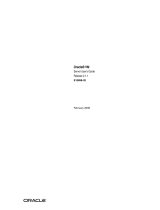Page is loading ...

© Novell Inc. All rights reserved
2
Agenda
•
Use cases
•
Terminology and Architecture
•
VM installation
•
Using Xen
•
Case Studies
•
Roadmap
•
Novell offerings
•
Helpful Links

© Novell Inc. All rights reserved
3
Server Virtualization: Analyst's View

© Novell Inc. All rights reserved
4

© Novell Inc. All rights reserved
5
●
Novell product portfolio offers choice
–
Customers can choose to deploy virtualization technologies
provided by Novell and other VT vendors
●
Novell virtualization strategy is focused on Xen
–
Customer demand for server consolidation and price /
performance will foster rapid acceptance
●
Novell supports customers
–
Virtual Machine Server Hardware from partners and Virtual
Machine configurations are listed in YES certification bulletins
–
Novell Technical Services supports installation and operation
Executive Summary

Use Cases

© Novell Inc. All rights reserved
7
Uses of Virtualization
Sharing
Aggregation
Examples: VMs, LPARs, Virtual Disks, VLANs
Physical
Resources
Virtual
Resources
Examples: Virtual Disks, Virtual Storage Pools
Physical
Resources
Virtual
Resources
Transparent Change
Examples: Spare CPU Substitution, CUoD
Physical
Resources
Virtual
Resources
Add or Replace
Extension
Examples: iSCSI, Architecture Emulators
Physical
Resources
Virtual
Resources

© Novell Inc. All rights reserved
8
Use cases
•
Virtualization allows for more flexibility
–
Virtual Machines (VM) isolate hardware differences due to a
abstracted resource layer between hardware and OS
–
Decouples software stacks from hardware life cycles
–
Dynamic provisioning reduces time to operation: pre-
configured application stacks are faster to deploy
–
Integrated high availability increases reliability
OS OS OS OS OS
VM Virtualization Layer
Hardware
A A A A A A A

Terminology and Architecture

© Novell Inc. All rights reserved
10
SLES 10 VM Server
SLES 9 and Windows XP - Fully Virtualized VMs

© Novell Inc. All rights reserved
11
Xen Technology Background
Originally a research project from University of Cambridge
Open source
Xen 2.0 released November 2004
Xen 3.0.0 released December 2005
Xen 3.0.2 release May 2006 (SLES 10 Target)
Xen 3.0.4 SLES 10 SP1 Target

© Novell Inc. All rights reserved
12
Xen Community Terminology
Domain: A container for a running virtual machine. Colloquially,
the VM itself.
Domain 0: The first domain. Privileged to manage other
domains. a.k.a. “dom0”.
Unprivileged domain: Any domain other than domain 0.
Cannot manage other domains. a.k.a. “domU”.
Driver domain: A domain that contains physical drivers. Usually
this is just domain 0.
Physical driver: A device driver (usually in the driver domain)
that talks to the hardware.
Virtual driver: A device driver (usually in a domU) that fullfills
requests by going to the physical driver.

© Novell Inc. All rights reserved
13
Full & Paravirtualization Overview
Virtual Machine Monitor
HW Platform
Virtual
Machine
Operating
System
Apps
Virtual
Machine
Operating
System
Apps
Full Virtualization
Runtime modification of Guest OS:
VMM manages the conflict, then
returns to OS
Virtual Machine Monitor
HW Platform
Virtual
Machine
Operating
System
Apps
A
P
I
A
P
I
Virtual
Machine
Operating
System
Apps
A
P
I
A
P
I
Paravirtualization
Static modification of Guest OS prior to
runtime: Privileged instruction calls are
exchanged with API functions provided
by the VMM
– Almost no performance degradation
– Significant scalability

© Novell Inc. All rights reserved
14
Novell Terminology
Fully Virtual: A VM mode that can run a native, unmodified
operating system by emulating all hardware devices.
Paravirtual: A VM mode that can run a modified operating
system, which cooperates with the VMM.
VT Computer: Computer supporting HVM Intel VT, AMD
Standard Computer: A computer that does not support
virtualization technology and therefore can run Xen VMs only in
paravirtual mode.
Native Operating System: A typical operating system that is not
optimized for the VM environment and must run in fully virtual
mode.

© Novell Inc. All rights reserved
15
Privilege Rings
Xen runs at ring 0 (highest privilege)
All domains run at rings 1 - 3.
•
Kernel is ring 1
•
User-space is ring 3
Applications Applications
Kernel Kernel
Linux Kernel
domain 0
(management)
Hypervisor (XEN)
Physical Hardware
ring 3
ring 1
ring 0
Events
Hypercalls

© Novell Inc. All rights reserved
16
Hardware assisted virtualization
•VT Computer
•
run multiple OS concurrently
•
protected execution environments
•
priviledge ring expansion
•
simplify hypervisor
•
Intel VT for directed I/O(VT-d) - direct assign I/O
–no emulated drivers necessary

© Novell Inc. All rights reserved
17
Extending Intel Virtualization
Technology
•
support for I/O device virtualization
–
direct I/O virtualization to the chipset(“VT-d”).
Currently, I/O devices aren’t aware of virtualization
and must go through the VMM before being
assigned to a virtual machine.
•
software emulation slow
–
Performance
>
I/O requests must traverse two I/O stacks (guest and host)
–
Functionality
>
Guest OSes “see” only restricted sets of legacy devices
–
Reliability
>
Drivers are potentially undependable if they run as part of privileged
software

© Novell Inc. All rights reserved
18
Full Virtualization Mode on VT
using qemu-dm
●
using “device model”
●
hypervisor intercepts mmio regions
●
forwards request to qemu
●
i.e.: read request to harddisk
●
VM emulates the following devices
●
requires the VM's operating system to install, load, and run its
native device drivers
●
Network card: AMD PCnet, NE2000
●
Disk drive: IDE
●
Graphics card: Cirrus Logic* GD5446, VESA-compliant VGA
●
Input: PS/2 mouse and keyboard
●
Sound: Creative* Sound Blaster 16, Ensoniq* ES1370

© Novell Inc. All rights reserved
19
Intel Pre- and Post-VT

© Novell Inc. All rights reserved
20
AMD IOMMU
•in DomU OS not loaded at address 0
•Xen: direct access to memory difficult-->corruption
•
hypervisor intervenes in I/O, apply translation-->overhead
•solutions:
•
rewrite graphics driver ?
•
HW to support IOMMU
•AMD IOMMU -provides isolation and memory protection
•IOMMU: device remap address accessed by HW,
/



